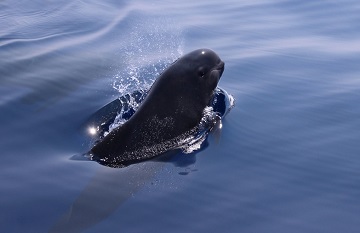640322-sly whale.jpg

Long-finned pilot whales like to talk. Credit: Hélène.Surmont, CC BY-NC-SA 2.0.
Long-finned pilot whales like to talk. They produce a wide variety of clicks, buzzes, whistles, and calls. That allows them to identify friends and family, even over long distances. And it may also help keep them safe from killer whales.
Long-finned pilot whales are fairly small as whales go. They can reach lengths of 20 to 25 feet, and weigh two or three tons. They have a stout body, with long, curving flippers. They live in pods of a dozen or so, headed by the mother of the clan. And the pods can cluster in groups of hundreds of animals.
There are two species of long-finned pilot whales. One inhabits the North Atlantic Ocean, from the Americas to Europe. The other lives in the Southern Ocean, which surrounds Antarctica. The populations might not have mixed with each other in more than 10,000 years.
But a recent study that listened to the sounds of southern whales for the first time found that many of their calls are almost identical to those of the northern population. It also found that many of the southerners perform “duets”—two whales singing together, with one starting and the other following along.
And like their northern cousins, the southern whales emit calls that are quite close to those of killer whales. The copy-cat calls may help the pilot whales evade detection by the killer whales. They could also help the pilot whales grab a few scraps left by the killer whales—sly calls that make life a little easier for these talkative whales.

